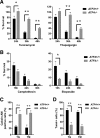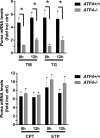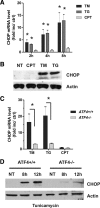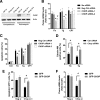Neuronal apoptosis induced by endoplasmic reticulum stress is regulated by ATF4-CHOP-mediated induction of the Bcl-2 homology 3-only member PUMA
- PMID: 21159964
- PMCID: PMC6634926
- DOI: 10.1523/JNEUROSCI.1598-10.2010
Neuronal apoptosis induced by endoplasmic reticulum stress is regulated by ATF4-CHOP-mediated induction of the Bcl-2 homology 3-only member PUMA
Abstract
An increasing body of evidence points to a key role of endoplasmic reticulum (ER) stress in acute and chronic neurodegenerative conditions. Extensive ER stress can trigger neuronal apoptosis, but the signaling pathways that regulate this cell death remain unclear. In the present study, we demonstrate that PUMA, a Bcl-2 homology 3 (BH3)-only member of the Bcl-2 family, is transcriptionally activated in cortical neurons by ER stress and is essential for ER-stress-induced cell death. PUMA is known to be a key transcriptional target of p53, but we have found that ER stress triggers PUMA induction and cell death through a p53-independent mechanism mediated by the ER-stress-inducible transcription factor ATF4 (activating transcription factor 4). Specifically, we demonstrate that ectopic expression of ATF4 sensitizes mouse cortical neurons to ER-stress-induced apoptosis and that ATF4-deficient neurons exhibit markedly reduced levels of PUMA expression and cell death. However, chromatin immunoprecipitation experiments suggest that ATF4 does not directly regulate the PUMA promoter. Rather, we found that ATF4 induces expression of the transcription factor CHOP (C/EBP homologous protein) and that CHOP in turn activates PUMA induction. Specifically, we demonstrate that CHOP binds to the PUMA promoter during ER stress and that CHOP knockdown attenuates PUMA induction and neuronal apoptosis. In summary, we have identified a key signaling pathway in ER-stress-induced neuronal death involving ATF4-CHOP-mediated transactivation of the proapoptotic Bcl-2 family member PUMA. We propose that this pathway may be an important therapeutic target relevant to a number of neurodegenerative conditions.
Figures











Similar articles
-
CHOP potentially co-operates with FOXO3a in neuronal cells to regulate PUMA and BIM expression in response to ER stress.PLoS One. 2012;7(6):e39586. doi: 10.1371/journal.pone.0039586. Epub 2012 Jun 28. PLoS One. 2012. PMID: 22761832 Free PMC article.
-
Regulation of gammaherpesvirus lytic replication by endoplasmic reticulum stress-induced transcription factors ATF4 and CHOP.J Biol Chem. 2018 Feb 23;293(8):2801-2814. doi: 10.1074/jbc.M117.813675. Epub 2018 Jan 5. J Biol Chem. 2018. PMID: 29305424 Free PMC article.
-
The proapoptotic BH3-only proteins Bim and Puma are downstream of endoplasmic reticulum and mitochondrial oxidative stress in pancreatic islets in response to glucotoxicity.Cell Death Dis. 2014 Mar 13;5(3):e1124. doi: 10.1038/cddis.2014.88. Cell Death Dis. 2014. PMID: 24625983 Free PMC article.
-
The Role of the PERK/eIF2α/ATF4/CHOP Signaling Pathway in Tumor Progression During Endoplasmic Reticulum Stress.Curr Mol Med. 2016;16(6):533-44. doi: 10.2174/1566524016666160523143937. Curr Mol Med. 2016. PMID: 27211800 Free PMC article. Review.
-
PUMA, a potent killer with or without p53.Oncogene. 2008 Dec;27 Suppl 1(Suppl 1):S71-83. doi: 10.1038/onc.2009.45. Oncogene. 2008. PMID: 19641508 Free PMC article. Review.
Cited by
-
Rescue of Glaucomatous Neurodegeneration by Differentially Modulating Neuronal Endoplasmic Reticulum Stress Molecules.J Neurosci. 2016 May 25;36(21):5891-903. doi: 10.1523/JNEUROSCI.3709-15.2016. J Neurosci. 2016. PMID: 27225776 Free PMC article.
-
De-repression of myelin-regulating gene expression after status epilepticus in mice lacking the C/EBP homologous protein CHOP.Int J Physiol Pathophysiol Pharmacol. 2014 Dec 15;6(4):185-98. eCollection 2014. Int J Physiol Pathophysiol Pharmacol. 2014. PMID: 25755840 Free PMC article.
-
Withaferin A and Celastrol Overwhelm Proteostasis.Int J Mol Sci. 2023 Dec 27;25(1):367. doi: 10.3390/ijms25010367. Int J Mol Sci. 2023. PMID: 38203539 Free PMC article. Review.
-
ER stress and apoptosis: a new mechanism for retinal cell death.Exp Diabetes Res. 2012;2012:589589. doi: 10.1155/2012/589589. Epub 2011 Dec 14. Exp Diabetes Res. 2012. PMID: 22216020 Free PMC article. Review.
-
The ClpP activator ONC-212 (TR-31) inhibits BCL2 and B-cell receptor signaling in CLL.EJHaem. 2021 Jan 14;2(1):81-93. doi: 10.1002/jha2.160. eCollection 2021 Feb. EJHaem. 2021. PMID: 35846080 Free PMC article.
References
-
- Averous J, Bruhat A, Jousse C, Carraro V, Thiel G, Fafournoux P. Induction of CHOP expression by amino acid limitation requires both ATF4 expression and ATF2 phosphorylation. J Biol Chem. 2004;279:5288–5297. - PubMed
-
- Bouillet P, Strasser A. BH3-only proteins: evolutionarily conserved proapoptotic Bcl-2 family members essential for initiating programmed cell death. J Cell Sci. 2002;115:1567–1574. - PubMed
-
- Bouillet P, Metcalf D, Huang DC, Tarlinton DM, Kay TW, Köntgen F, Adams JM, Strasser A. Proapoptotic Bcl-2 relative Bim required for certain apoptotic responses, leukocyte homeostasis, and to preclude autoimmunity. Science. 1999;286:1735–1738. - PubMed
Publication types
MeSH terms
Substances
Grants and funding
LinkOut - more resources
Full Text Sources
Molecular Biology Databases
Research Materials
Miscellaneous
